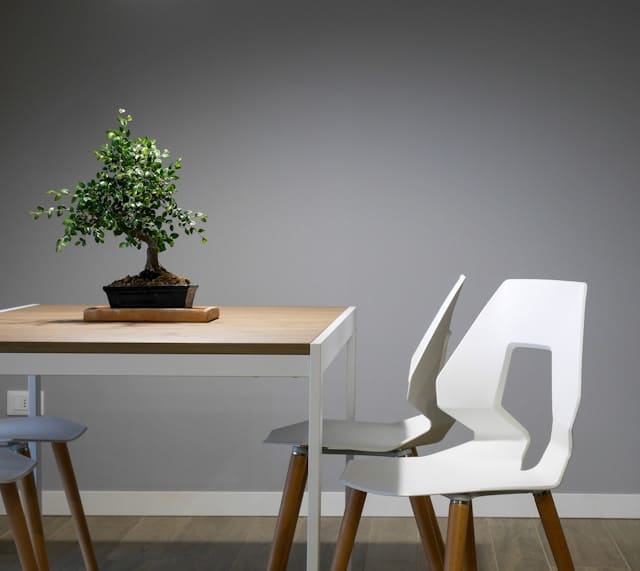What’s the Best Technique for Cultivating an Indoor Bonsai Tree Display?

Immerse yourself in the art of cultivating bonsai, the ancient practice of growing small trees that mimic the shape and scale of full-sized trees. The magic of a bonsai tree lies in its ability to add charm and serenity to your indoor space. From selecting the right species, lighting and watering conditions, to potting, pruning and overall care, we will guide you through the journey of nurturing your indoor wonder.
Choosing the Right Bonsai Species
Choosing the right bonsai species is an essential first step towards setting up your indoor bonsai display. Not all trees are suitable for indoor growing, as most bonsai trees are variations of outdoor, woody plants. However, certain species of bonsai adapt well to the indoor environment, with the correct care.
Cela peut vous intéresser : How to Plan a Seamless Indoor-Outdoor Transition in a Bungalow?
Tropical or subtropical species can be a good choice for indoor bonsai due to their ability to adapt to lower light conditions. Some popular indoor bonsai species include the Ficus, Jade Plant, and the Brazilian Rain Tree. These trees thrive well indoors as they are naturally adapted to less light and higher humidity, similar to their native tropical environments.
Choosing the right species also means considering the tree’s size and the available space in your home. Dwarf or miniature bonsai trees have small root systems, making them ideal for indoor cultivation.
A découvrir également : What’s the Ideal Setup for an At-Home Dialysis Patient to Ensure Comfort and Accessibility?
Soil, Water, and Light: Essential Elements of Bonsai Care
While the right bonsai species is key, its growth and survival also hinge on the right soil, water, and light conditions. Different species require varying soil types. Most bonsai trees thrive in a well-draining soil mix, which is critical to prevent root rot.
When it comes to watering, bonsai trees require a delicate balance. Overwatering can lead to root rot, while under-watering can cause the tree to dry out and die. The key is to ensure that the soil is evenly moist, not soaking wet. Regular misting can also help maintain the right humidity levels for the tree.
Light is another crucial factor. Most indoor bonsai trees are adept at surviving in low-light conditions. However, they still need a good amount of indirect sunlight to thrive. Place your bonsai near a window that receives plenty of natural light, but avoid direct sunlight as it can scorch the leaves.
Potting and Pruning Your Bonsai
With the right species and ideal conditions secured, you can now attend to potting and pruning your bonsai – an integral part of its care.
The pot for your bonsai tree should be proportional to its size. The size and depth of the pot can affect the growth of the tree, so it is vital to choose correctly. A shallow, wide pot is generally suitable for most indoor bonsai trees, as it allows the roots to spread and grow.
Pruning is not just about shaping your bonsai but also contributes to its overall health. Regular pruning helps maintain the tree’s shape and promotes new growth. Pruning the roots, on the other hand, is done to keep the tree small and to encourage a dense network of small roots.
Nurturing Bonsai Growth
In the art of bonsai, patience is key. Bonsai trees grow slowly, and shaping them to your liking can take years. However, with consistent care, your tree will grow and flourish.
Monitor your tree’s growth frequently, adjusting care as necessary. If you notice yellowing leaves, this can indicate a watering or lighting issue. If the tree seems to be growing too big for its pot, it may be time for a new one or root pruning.
One of the fascinating aspects of bonsai trees is their ability to reflect the seasons, even indoors. Some species may lose leaves in the winter, just as they would outdoors. Don’t be alarmed by this; it’s a sign of a healthy, thriving bonsai.
In essence, cultivating an indoor bonsai tree display is an exercise in patience, mindfulness, and consistent care. The reward is a serene and aesthetically pleasing addition to your indoor living space. Remember to monitor your tree, adjust care as needed, and most importantly, enjoy the process. Each phase of growth marks a new chapter in your bonsai’s life, reflecting the ever-changing beauty of nature indoors.
Fertilizing and Repotting Bonsai
The next step in the bonsai cultivation journey involves two crucial practices – fertilizing and repotting. Understanding the nuances of these practices can have a significant impact on the health and appearance of your bonsai tree.
Fertilizer is a key component in bonsai care. Since the bonsai pot limits the root system and the amount of nutrients the tree can obtain from the soil, fertilizing becomes vital. During the growing season, typically spring and fall, your bonsai tree will benefit from a balanced fertilizer. Avoid fertilizing during the more dormant winter months as the tree is less active and less able to utilize the nutrients.
Repotting bonsai trees is another crucial aspect of bonsai maintenance. Over time, the tree’s roots can become pot-bound, inhibiting growth and depleting the soil. Repotting your tree in fresh bonsai soil can stimulate growth and ensure long-term health. The frequency of repotting largely depends on the tree’s growth rate and age. Young trees typically require repotting every two years, while mature trees can go for three to five years. Signs that your bonsai will need repotting include slower growth or water draining poorly from the pot.
When repotting, it’s important to prune the root system. This encourages the growth of smaller, fibrous roots that absorb nutrients more efficiently. Pruning also helps maintain the small size of the bonsai tree.
The Art of Shaping Your Bonsai
A captivating part of the bonsai experience is shaping your bonsai. This creative process involves wiring and pruning branches to achieve your desired aesthetic. It’s important to remember that shaping should be done gradually and with care to avoid damaging the tree.
Wiring is a common technique used to shape bonsai trees. Using wire to gently guide the branches can help achieve the desired shape over time. The wire should be applied when the bonsai is in its dormant phase, typically in winter, to limit stress on the tree. The wire should be removed before it starts to cut into the bark.
Pruning is also crucial in shaping your bonsai. Unlike root and branch pruning for health, this is about creating your tree’s ideal look. Pruning encourages branching and can be used to create a sense of scale, making the bonsai appear like a full-sized tree.
Remember that indoor bonsai trees are living works of art that evolve with each season. As the tree grows, continual adjustments may be required to maintain the desired shape. This ongoing interaction with your tree is part of the joy of bonsai cultivation.
Conclusion: The Rewarding Journey of Indoor Bonsai Cultivation
Cultivating an indoor bonsai tree is a rewarding journey that requires time, patience and dedication. From selecting the right bonsai species and understanding its specific needs, to mastering the techniques of pruning, shaping, and repotting, each step is an opportunity to learn and grow along with your bonsai tree.
Bonsai cultivation is not just about maintaining a miniature tree indoors. It’s about engagement with the natural world on a small scale, in your own living space. The indoor bonsai becomes a reflection of nature’s vastness and complexity, embodying the changing seasons and the cycle of growth and dormancy.
The joy of bonsai lies not just in the end result but in the process itself. So, as you embark on your bonsai journey, remember to savor each moment. From the first sprouts of new growth in the spring to the quiet hibernation in winter, each phase of your bonsai’s life is a testament to nature’s resilience and beauty. Enjoy the journey, and let your indoor bonsai tree serve as a daily reminder of nature’s enduring allure.
